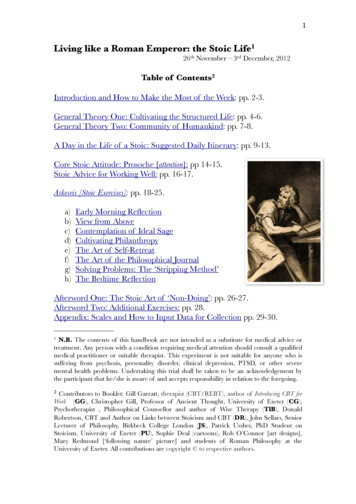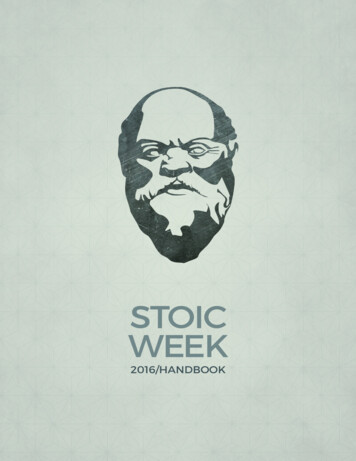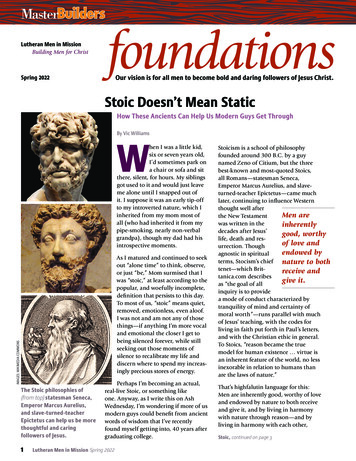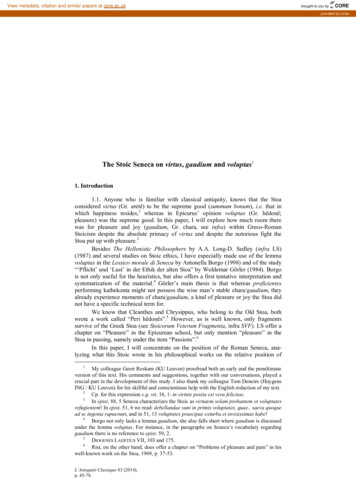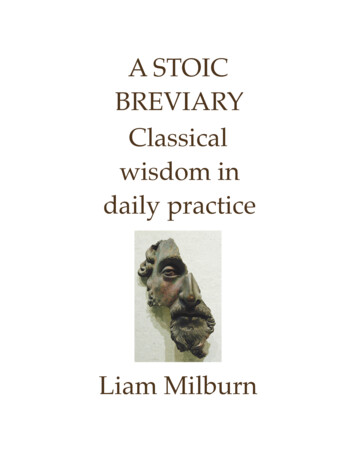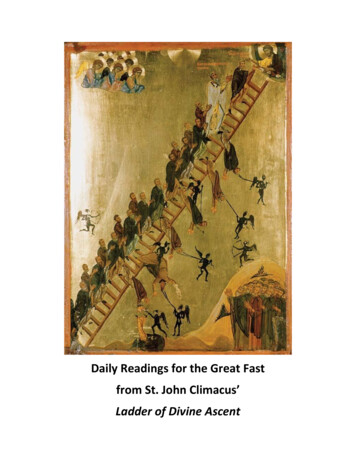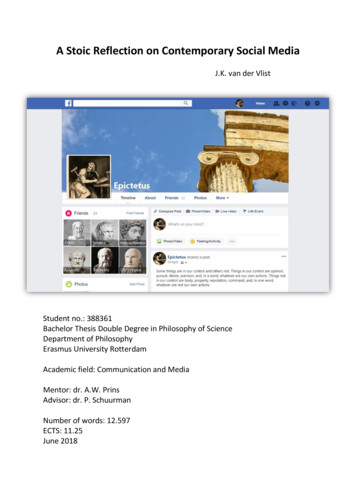
Transcription
A Stoic Reflection on Contemporary Social MediaJ.K. van der VlistStudent no.: 388361Bachelor Thesis Double Degree in Philosophy of ScienceDepartment of PhilosophyErasmus University RotterdamAcademic field: Communication and MediaMentor: dr. A.W. PrinsAdvisor: dr. P. SchuurmanNumber of words: 12.597ECTS: 11.25June 2018
2018J.K. van der VlistALL RIGHTS RESERVED
AbstractThe prevalent mental health issues of particularly younger generations are often beingascribed to contemporary social media usage. Since some of the key notions ofcontemporary cognitive behavioural therapies, which are often employed to battle mentalhealth issues such as anxiety or depression, can be traced back to ancient Stoic philosophy,this thesis aims at critically reflecting on social media practices from a Stoic perspective. Byapplying Stoic philosophy to three problematic and typical social media phenomena (envy,judging and fear of missing out), the arising discrepancies are being discussed. Due to theapparent incongruities, a different kind of approach to our interconnected existence isargued for.Keywords: cognitive behavioural therapies, Stoicism, social media
For sophiathe highest virtue
AcknowledgementsFirst and foremostly, I want to thank dr. A.W. Prins for being my mentor in this process aswell as a continuing source of inspiration throughout my studies. Secondly, I would like tothank my adviser, dr. P. Schuurman, for the useful suggestions he made. Moreover, I amgrateful to my parents for always supporting me in my academic endeavours. Finally, specialthanks go out to my closest friends for having the patience to sit through my Stoic rants.
PrefaceDuring the spring of 2017, I first came into contact with Cognitive Behavioural Therapy. Atthe time, I was a beginning philosophy student who doubted about the usefulness of such atherapy for me. However, when I did some research about these therapies, I discovered thatthe fundamental notions on which these therapies are based, can be traced back to ancientStoic philosophy. I had only had one lecture about Stoic philosophy and, ironically enough, Ispent most of that lecture being angry due to an argument I had prior to that lecture. Afterthe discovery of the philosophical roots of these therapies, I decided to buy some Stoicliterature. Soon, I realized that my way of acting and thinking was at times diametricallyopposed to what the Stoics suggested would lead to a happy life. After a while, I beganapplying the Stoic wisdoms in all kinds of situations and I started to experienceimprovements with regard to how I dealt with them.I do not think I am the only one who sees the benefits of adopting a Stoic attitude inour modern lives. There currently is a resurgence in the popularity of Stoicism. In recentyears, there have been multiple Stoic best-sellers, annual Stoic weeks have been organisedat universities and Stoicism is even the talk of the tech-town Silicon Valley. My adviser dr. PSchuurman rightfully pointed out that one of the reasons Stoic philosophy may be soappealing to many, could lie in the fact that the selfish character of Stoicism is verycompatible with the highly individualised lifestyles of internet millennials. Although theStoics had a slightly different conception of what happiness entails than many people dotoday, they also held every person accountable for their own happiness. However, thishappiness is not easily achieved according to the Stoics. Nevertheless, the Stoic philosophydoes provide very powerful ‘tools’ that will come in ‘handy’ in all kinds of contemporarysituations.Being a communication and media graduate, I also applied my newly acquired Stoicwisdoms to my academic field. I noticed a lot of incongruities between the ways we usesocial media and the desired Stoic attitudes. Hence, I decided to combine my academicinterest for the purpose of a bachelor thesis and this is the result.
Table of ContentsIntroduction .1Part I1.1 Stoic Literature .61.2 An Introduction to Stoicism . 6Part II2.1 Stoicism Applied to Contemporary Social Media Usage .132.2 Envy .132.3 Judging 192.4 Fear of Missing Out 23Part III3.1 Conclusions and Reflections 283.2 A Stoic Approach to Social Media 293.3 Concluding Remarks . 31Bibliography .34
IntroductionThe internet has made our lives much easier in many ways. We can do all sorts of thingsonline. We can buy anything online, from clothes to groceries and from holidays tocryptocurrencies. We can educate ourselves online, for instance through online newssources or MOOCs (Massive Open Online Course). We also entertain ourselves online; westream movies and music through online platforms. The possibilities of the internet arevirtually limitless. One of the most important affordances1 of the internet, however, is beingable to communicate with each other, ‘to stay in touch’. Whereas the physical postcardmade way for the email, nowadays social media have grown to be, arguably, the mostimportant means of (mediated) communication. According to their own statistics, as ofMarch 2018, Facebook has 2.2 billion monthly active users of which 1.45 billion visit theirplatform on a daily basis.2 Likewise, the photo-sharing application Instagram has over 800million monthly users of which the majority (500 million) use the platform every day.3Although individual social media platforms can be subject to varying popularity, it seems likesocial media in general have grown to play an indispensable role in many of our lives.4Social media platforms, and in particular Social Networking Sites, are praised formany things. Not only is it easier to contact and ‘follow’ family and friends wherever theymight be on this globe, social media are predominantly praised for how they allow forcommunity building. This applies to people living in remote areas, ethnic minoritypopulations and marginalised or vulnerable social groups such as the LGBTQ community.5By facilitating the connection with peers or like-minded people, social media do not merelyserve a communal purpose but often transcend it. In this way, the use of social media can beemployed in all sort of environments. To illustrate: social media are helpful forThe concept of affordance has been introduced by James Gibson to account for “how various usersmay perceive and therefore use the same object, such as a rock or a door handle, in widely differentways” (Cited from Emmanuelle Vaast and Evgeny Kaganer, “Social Media Affordances andGovernance in the Workplace: An examination of organizational policies,” Journal of ComputerMediated Communication 19: 79).2 “Company Info,” Facebook, accessed May 14, 2018, https://newsroom.fb.com/company-info/; Theseare the most recent quarterly figures. Facebook has since been involved in a privacy scandal.However, for the purpose of this thesis, it is not relevant to discuss it.3 “Our Story,” Instagram, accessed May 14, 2018, https://instagram-press.com/our-story/.4 Kaya Yurieff, “Snapchat stock loses 1.3 billion after Kylie Jenner tweet,” CNN, February 23, 2018.5 Royal Society for Public Health, "Status of Mind: Social media And young people's mental healthand wellbeing", 2017,14, be270a-a55f-4719ad668c2ec7a74c2a.pdf; LGBTQ stands for Lesbian, Gay, Bisexual, Transgender and Queer. The sign is generally added to include other sexualities as well.11
communication in health care environments.6 Besides emotional support, social media allowpatients to engage with health experts or people with similar diagnoses, sometimes leadingto improved health outcomes. In addition to maintaining friendships, experiencing a senseof community, obtaining access to all sorts of information and gaining emotional support,people also use social media as valuable means to express themselves. Posting pictures,sharing thoughts and liking (or disliking) other people’s content is what social media are allabout. Through social media people constitute their own identities, or at least try to shape afavourable narrative about themselves, primarily to be perceived by others.Whereas the interconnectedness that social media offer has opened doors for manypeople and brought them together, people are beginning to see that it also takes its toll.Sherry Turkle, a renowned professor at MIT, who, in her own words, used to “celebrate ourlives on the internet”,7 now paints a less favourable picture of the effects of ourinterconnected digital lives. In Alone Together, which has become a much-cited work in theacademic fields of communication and psychology, Turkle argues that the substitution ofmany of our ‘real’ forms of contact by mediated digital contact, has a harmful impact onhow we relate with each other.8 Paradoxically, she argues, we are more connected withothers than we have ever been, yet we lose the capacity to really connect with each otherwhich ultimately makes us feel lonelier. Similar worries come from Jean Twenge, agenerational researcher, who states that there is compelling evidence that smartphones andsocial media have a harmful impact on the mental health of the generation that comes afterthe Millennials, which she has coined generation ‘iGen’.9 This generation is made up of socalled digital natives, people who have grown up in the digital age and often cannotremember life before the internet. It is also people from these younger generations whohappen to be most represented on social media platforms. In her research, Twenge has6Royal Society for Public Health, "Status of Mind,” 13; See also: S. Anne Moorhead et al., "A NewDimension of Health Care: Systematic Review of the Uses, Benefits, and Limitations of Social Mediafor Health Communication", Journal of Medical Internet Research 15, no. 4 (2013): e85,doi:10.2196/jmir.1933.7 Sherry Turkle, "Connected, but alone?," TED video, 19:42, filmed February 2012,https://www.ted.com/talks/sherry turkle alone together; Turkle’s more optimistic works regardingtechnology include The Second Self (1984) and Life on the Screen (1995).8 Sherry Turkle, Alone Together: Why We Expect More from Technology and Less from Each Other(New York: Basic Books, 2011). Passim.9 Jean Twenge, “Have Smartphones Destroyed a Generation?,” The Atlantic, September 34198/.2
found that “teens who spend more time on screens are more likely to be depressed, andthose who spend more time on nonscreen activities are less likely to be depressed”.10 Inaddition, her research shows a dramatic deterioration of the mental health of teens ingeneral; depression and suicide among teenagers have increased a lot, they sleep less andare feeling lonelier.11 Twenge’s American findings seem to correspond with findings fromthe United Kingdom, where the use of social media is linked to increased chances of anxietyand depression as well as having a negative body image.12 On top of that, ‘quarter lifecrises’13 and burn-outs (for instance among students)14 are widely discussed in the publicdebate. Equally, phenomena such as ‘FoMO’ (Fear of Missing Out), a term which is used todescribe the experience of feeling like having to do as much as possible to avoid feeling leftout or missing anything, are increasingly being researched and studied in terms of its effecton mental health.15 In short, there are worrying signals about the mental health ofparticularly younger generations. On the one hand, depression, anxiety, stress and burnoutsseem to be becoming more prevalent, and on the other hand, more time is spent connectedonline and on social media platforms.One of the main approaches that is being employed to battle such forms ofpsychological disorders as mentioned above, is cognitive behavioural therapy (CBT).16Cognitive behavioural therapies have become the predominant form of modernpsychological therapy, in all probability mainly due to two important factors.17 Not only arecognitive behavioural therapies highly cost-effective, there also exists a lot of researchsupporting the effectiveness of these evidence-based methods.18 Although there aremultiple variations of CBT, what they have in common is that all assume that (1) cognitive10Jean M. Twenge, iGen: Why Today's Super-Connected Kids Are Growing Up Less Rebellious,More Tolerant, Less Happy--and Completely Unprepared for Adulthood--and What That Means for theRest of Us (New York: Atria Books, 2017), 82.11 Twenge, “Have Smartphones Destroyed a Generation?”12 Royal Society for Public Health, "Status of Mind,” 8-10.13 Sarah Young, “More than half of Millennials are going through a 'Quarter-Life Crisis',” TheIndependent, March 13, 2018, operty-first-direct-a8253036.html.14 Jeanine Duijst, “Zelfs mijn ouders weten niet van mijn burn-out,” NOS, October 21, -ouders-weten-niet-van-mijn-burn-out.html.15 Jon D. Elhai et al., "Fear of missing out, need for touch, anxiety and depression are related toproblematic smartphone use", Computers in Human Behavior 63 (2016): 16 Donald Robertson, The Philosophy of Cognitive-Behavioural Therapy (CBT) (London: KarnacBooks, 2010), xi-xii.17 Ibid. 3.18 Ibid. xi.3
activity influences behaviour and that (2) cognitive activity can be changed, whichsubsequently (3) can result in changes in behaviour.19 In other words, these therapies areaimed at changing people’s thoughts or perceptions concerning matters and events in thehope of bringing about a positive change in behaviour or the experience of the matter athand. The most famous and influential forms of CBT are Albert Ellis’ Rational EmotiveBehaviour Therapy and Aaron Beck’s cognitive therapy. Both these and other forms of CBThave proven to be successful and are widely recommended for combatting depression andanxiety-related disorders.20Some of the key notions of these contemporary forms of CBT, can be traced back toancient Stoic philosophy. Both Ellis and Beck are very explicit about the Stoic philosophicalorigins of their cognitive therapies.21 While this acknowledgement might come across asremarkable at first, it really is not. In ancient history, and particularly in the Hellenisticperiod, when someone would suffer from a physical discomfort, they would visit a doctor;when, on the other hand, the problem was of psychological nature, they would visit aphilosopher.22 Chrysippus of Soli (c. 279 – c. 206 BC), one of the early expanders of Stoicism,called the work of philosophers that of the “physician of the soul”.23 The Stoic art of living isthus a very practical philosophy since it essentially prescribes the manner in which is oughtto be acted and thought. The ultimate goal for a Stoic is to live a happy life, one that is freeof destructive and negative emotions. The Stoics held a cognitive view of emotion; theybelieved that negative emotions, or rather ‘passions’, such as anger and envy are the resultof fallacious thinking and are therefore irrational and can be avoided.24 Moreover, the Stoicart of living advocates to accept the things which are beyond our control. According toStoicism, only when things that are out of reach are accepted and complete control isgained over thoughts, emotions and desires, a happy and free life can be attained.25Following this line of thought, starting with the worrying signals about the mentalhealth of particularly younger generations and how these issues are often being ascribed to19Robertson, Philosophy of CBT, 4.Ibid. xi.21 Ibid. 5.22 Miriam van Reijen, Stoïcijnse levenskunst: Evenveel geluk als wijsheid (Leusden: ISVW Uitgevers,2017), 16.23 Robertson, Philosophy of CBT, xix.24 Reijen, Stoïcijnse levenskunst, 16.25 Epictetus, Enchiridion, trans. Elizabeth Carter (Massachusetts: The Internet Classics Archive, n.d.),§1, 4
contemporary social media usage and, subsequently, from cognitive behavioural therapieswhich are employed to treat mental health issues to their Stoic philosophical underpinnings,there is sufficient ground for a philosophical reflection. A reflection in which key themes andvalues of an ancient philosophy that is more than two millennia old, are being applied to thewidespread contemporary usage of the technologically advanced social media.Therefore the main question this thesis aims to answer is how do Stoic philosophyand everyday behaviour on social media platforms relate to each other? What is there to belearned from the Stoic art of life? Could Stoics, for example, have used social media if theywere available at the time and if so, how? Can their cognitive view of emotions improve ourmental health, or rather: keep our minds healthy? The remainder of this thesis will besubdivided into three parts. I will first proceed to delineate the Stoic philosophy moreelaborately in Part I. Subsequently, I will apply the Stoic philosophy to typical, everydaysocial media practices in Part II. In the last part of this thesis (III), I will draw conclusionsfrom the incongruities that might arise and aim at sufficiently answering the questionsposed in this introduction as well as argue for a different kind of approach to ourinterconnected existence.5
Part I1.1 Stoic LiteratureBefore outlining the Stoic art of living in further detail, I want to spend some wordsjustifying the choice of literature on which this thesis is based. Much of what we know todayof Stoic philosophy has survived through the last ‘wave’ of Stoics so to speak, often calledthe “late” or “Roman Stoa”. During the Roman Empire, Stoicism was widespread andbecame one of the major philosophical schools.26 It is also during this time that the mostfamous and best-read Stoics were alive. Among these are of course Seneca (c. 4 BC – AD 65),Epictetus (AD c. 55 – 135) and emperor-philosopher Marcus Aurelius (AD 121 – 180).27While writing a thesis on Stoic philosophy, I found it very important to consult some of theiroriginal works. These original works will mostly be employed when applying Stoicism tocontemporary social media usage. Arguably, the most important Stoic work is Epictetus’Enchiridion, which translates to Handbook. Strictly speaking, Epictetus did not write thisbook, his student Arrian of Nicomedia (AD c. 86 – 160) compiled it, based on his lectures.28 Itforms a concise overview of what the Stoic philosophy entails. It is full of Stoic teachings,and as the name suggest, it contains knowledge every Stoic should have ‘at hand’. Besidesthe Enchiridion, two of Seneca’s writings, Of a Happy Life (De Vita Beata) and On theShortness of Life (De Brevitate Vitae), have been consulted. In addition to original Stoicworks, three books which appeared more recently have been examined. How to be a Stoicby Massimo Pigliucci, Stoïcijnse levenskunst by Miriam van Reijen and The Philosophy ofCognitive-Behavioural Therapy (CBT) by Donald Robertson. Whereas the former two booksserve as modern introductions to the ancient Stoic wisdoms, the latter outlines theconnection between Stoic philosophy and contemporary cognitive therapies. All thesebooks combined provide a thorough and sufficient overview of Stoicism at an appropriatelevel and depth for the purpose of this thesis.1.2 An Introduction to StoicismIf the purpose of this thesis were to encompass the complete Stoic school of philosophy, itwould be a very demanding and difficult endeavour. Not only due to the fact that many of26Massimo Pigliucci, How to be a Stoic, (London: Rider, 2017), 20-21.Ibid. 21.28 Ibid. 202.276
the writings of the ‘early’ and ‘middle Stoa’ have not survived, but, more importantly, thephilosophy of the Stoa was not necessarily a singular, coherent, unambiguous philosophy.The reason is that, similar to the Epicurean Garden or Plato’s Academy, the Stoa were firstand foremost a spatial designation.29 It was at the Stoa Poikile (‘painted porch’), a publiccolonnade in Athens, at which the founder of Stoicism, Zeno of Citium (c. 334 – c. 262 BC),first began lecturing on various topics to anyone that would come and listen.30 Zeno hadbeen a follower of Crates (c. 365 – c. 285 BC), who was a Cynic and disciple of Diogenes ofSinope (c. 412 – c. 323 BC).31 For the Cynics, as is true for all the other Hellenistic schools ofphilosophy (to which Stoicism belongs as well), the goal of life was eudaimonia, which canbe best described as living a flourishing or happy life.32 According to the Cynics, the onlything needed to live a eudaimonic life is virtue, therefore they renounced all material andimmaterial personal attachments.33 The aforementioned Cynic Diogenes of Sinope took thisasceticism to the extremes: he lived in a tub on the streets of Athens, where he becamenotorious for his odd demeanour such as defecating and performing sexual acts in public.34Not quite unfitting is it then, that the word ‘Cynic’ is derived from the Greek word for dog.35It is quite plausible that Zeno did not look forward to such an ascetic life and decided tostart his own school.The philosophy of the Zenonians, who quickly became known as the Stoics, can bepositioned as a sensible mix of the philosophy of the Cynics on the one hand and theAristotelian Peripatetic school on the other.36 Aristotle (384–322 BC) identified twelvevirtues which, if practiced correctly and when combined with some external factors such ashealth, wealth, education, could lead to a eudaimonic life.37 Hence, for Aristotle, and thuscontrary to the Cynic belief, attaining a happy life is at least partly dependent on the cardsone has been dealt in life. However, the Stoics opposed the Peripatetic idea that aeudaimonic life is to some extent reliant on external goods, but conceded, contrary to theCynics, that some circumstances are more favourable than others. They named these29Reijen, Stoïcijnse levenskunst, 32.Pigliucci, How to be a Stoic, 18.31 Ibid. 238.32 Pigliucci, How to be a Stoic, 234.33 Ibid. 73.34 Ibid. 74.35 Reijen, Stoïcijnse levenskunst, 20.36 Pigliucci, How to be a Stoic, 74-75.37 Ibid. 236.307
‘preferred indifferents’. These indifferents are comprised of everything that is beyond one’sown (virtuous) character, for example money, friends, a car, a good health or even freedom.These are things everyone (except maybe some Cynics) rather has than lacks. However, ifthe possession of these indifferent externals compromises one’s virtuous character, a Stoicwould be wise enough to abstain from them. In this way, these indifferents also serve adidactic purpose: they can help make the distinction between good and bad. As Stoics arenot ascetic per se, it is acceptable for them to favour being rich over being poor and beinghealthy over being sick or disabled. Nonetheless, such ‘externals’ should not interfere withsomeone’s virtues and moral integrity.38 This also means that sickness and poverty do notnecessarily lead to an unhappy life. Since the possibility of a eudaimonic life is containedwithin and should not be externally attributed, the Stoic philosophy is essentially verydemocratic: anyone can practice it regardless of their social status. Since the Stoicsconsidered social status and a good reputation to be among these preferred indifferents, itfollows that Stoics believed that every person is fundamentally equal.39 It is a bit paradoxicalthat the Stoics held such a view during a time in which slavery was very common. Epictetus,who grew to be an important figure in Stoic history, even used to be a slave prior to hisphilosophical endeavours. The Stoics were, nevertheless, early cosmopolitans; they werecitizens of the world who argued that every person ought to be treated as if they are one ofour relatives.40 Some Stoics even extended this view by including other sentient beings aswell. Reportedly a number of Stoics were vegetarians.41 In Stoic eyes, everybody is equaland has equal chances to live a happy life.According to Stoic understanding, in order to reach eudaimonia, virtues should becultivated. Many of the Stoic conceptions of virtue, were adopted from Socrates (c. 470 –399 BC).42 Similar to Socrates, the philosophy of the Stoa emphasized four cardinal virtues:(practical) wisdom, courage, temperance and justice.43 Again, analogous to Socratic belief,wisdom is the highest possible good for the Stoics, as there is no conceivable situation in38Pigliucci, How to be a Stoic, 199.Reijen, Stoïcijnse levenskunst, 33.40 Pigliucci, How to be a Stoic, 60-61.41 Ibid. 69.42 Ibid. 98.43 Ibid. 99.398
which it is not desirable.44 Wisdom also always precedes the other virtues, as it is forinstance needed to determine what is just or when it is desired to react in a courageousmanner. These four cardinal virtues are therefore different manifestations of the highest—yet underlying—virtue of wisdom. For them, practicing these virtues is sufficient for a happylife.45 However, Seneca tells us that it is not the joy that arises from doing virtuous deedsthat leads to a happy life and people should not be mistaken to act virtuous for their ownsake and pleasure.46 They should act virtuous for virtue’s sake because there is no guaranteethat the desired external outcomes will follow, as that is beyond one’s control. However,people do have control over their own actions and by focussing on them and trying to act ina virtuous manner at all times, life will become more eudaimonic. Most of the Stoicphilosophy is therefore aimed at prescribing how people ought to act in accordance withthese four virtues. For this reason, Stoic virtue ethics is essentially very pragmatic.Much of this pragmatism is directed towards dealing with the impressions that arisefrom situations and occurrences. The Stoic philosophy does not teach how people shoulddeal with their emotions and sorrows, simply—to put it in the same manner as in thepreface of van Reijen’s Stoijcijnse levenskunst—because people do not visit the dentist tocope with a toothache, but to tackle the cause effectively.47 There is a commonmisconception about Stoic philosophy that is very apparent in modern day references inwhich someone (or their reaction) is described as ‘stoic’. In most of these cases, someoneaims to characterize another person as insensible, apathetic or numb, typically devoid offeelings. Indeed, Stoics believed that negative emotions such as anger, sadness or anxietystand in the way of a happy life. However, this does not mean that Stoics are insensitive.Rather, as Pigliucci puts it, “[Stoicism] is about acknowledging our emotions, reflecting onwhat causes them, and redirecting them for our own good”.48 Stoics wanted to achieve astate of what was called apatheia. It is a negative Stoic ideal, meaning the absence of pathèor passions, which are the negative emotions.49 The word passion literally means ‘suffering’.44Pigliucci, How to be a Stoic, 98; To be precise, the Stoics (in a similar way as some of theirpredecessors from other Hellenistic Schools of Philosophy) distinguished between a more practicalwisdom, phronesis, and wisdom as the highest virtue, sophia.45 Seneca, Of a Happy Life (De Vita Beata), trans. Aubrey Stewart (London: George Bell and Sons,1900), Book XVI, https://en.wikisource.org/wiki/Of a Happy Life.46 Seneca, Of a Happy Life, Book XV.47 Reijen, Stoïcijnse levenskunst, 8.48 Pigliucci, How to be a Stoic, 2.49 Reijen, Stoïcijnse levenskunst, 33.9
Experiencing passions, thus, means to suffer and to undergo something unpleasant withoutbeing in control. Naturally, passions (negative emotions) are detrimental for happiness.Apatheia, in turn, is necessary to reach ataraxia, meaning the tranquillity of mind. Aeudaimonic life, according to the Stoics, is essentially a kind of imperturbable state of beingin which someone’s happiness is unaffected by external situations or occurrences and theydo not experience negative emotions. Therefore, Stoic happiness is not some kind of joyouspeak, but should be regarded as the absence of deep valleys.50It is a demanding effort to achieve a eudaimonic life, causing an absence of negativeemotions (apatheia) and, subsequently, attaining a calmness of mind (ataraxia). Central totheir philosophy, Stoics therefore used the guiding principles of reason. The study of formalreasoning (propositional logic) can actually be traced back to the ancient Stoics, who madefundamental contributions to it.51 Contrary to Epicurus (341 – 270 BC) and his followers whowere less deterministic, the Stoics firmly believed in the principle of causality.52 According tothem, the universe is rationally structured through Logos.53 Nature is eminently reasonableand therefore identical to this concept of Logos. This means that the universe can beunderstood rationally. Although slightly simplified, the Stoic God can be interpreted asanother way to describe this Nature or Logos.54 Hence, the Stoic God can be viewed as animmanent and material God that is pantheistic.55 It is this Stoic conception that served as amajor influence to the philosophy of seventeenth-century Dutch philosopher BaruchSpinoza (1632 – 1677), who was known to be in possession of Epictetus’ Enchiridion as wellas some of Seneca’s works.56 According to the Stoics, reason should be employed both inmaking sense of every situation as well as upon deciding how to virtuously respond to them.In this sense, every happy person is autarkic due to the fact that the combination of the useof reason, self-control and acting in a virtuous manner are decisive as well as sufficient fortheir ultimate happiness. A happy life, t
years, there have been multiple Stoic best-sellers, annual Stoic weeks have been organised . platform on a daily basis.2 Likewise, the photo-sharing application Instagram has over 800 million monthly users of which the majority . ad668c2ec7a74c2a.pdf; LGBTQ stands for Lesbian, Gay, Bisexual, Transgender and Queer. The
